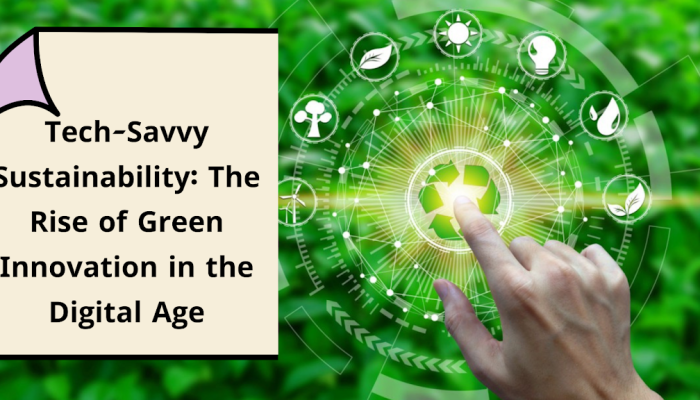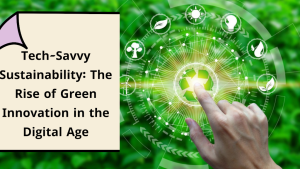The quest for sustainability has expanded in the era of digital technology. Rapid technology breakthroughs have made green innovation a crucial component of international efforts to mitigate climate change and lessen environmental damage. Businesses and individuals are using technology to address environmental concerns as societies become more aware of their carbon footprints. This is creating a wave of tech-savvy sustainability that has the potential to completely transform lifestyles and sectors. Technology and sustainability are coming together to create a dynamic ecosystem that is powerfully combining digital transformation, environmental stewardship, and innovation.
The Digital Transformation of Sustainability
Governments, corporations, and communities have long sought to attain sustainability; but, the digital era has brought with it new methods and instruments for doing so. The development of artificial intelligence, the Internet of Things (IoT), and big data has made it possible to monitor, analyze, and optimize resource consumption more effectively. With the help of these technologies, environmental impacts can be understood more precisely and provide useful information for reducing waste and energy use.
Among the biggest developments in this field is the application of smart systems, which combine technology with environmental initiatives. For instance, smart grids maximize the distribution of energy and minimize waste by anticipating demand and modifying supply accordingly. In addition to reducing energy overproduction, this facilitates improved grid integration of renewable energy sources like wind and solar power. In the field of agriculture, smart farming methods maximize water use, minimize environmental harm, and increase crop yields while reducing the use of pesticides and using sensors, drones, and data analytics.
Digital technologies like automation and 3D printing have revolutionized the manufacturing sector by enabling more efficient and waste-free product production. Designing products with sustainability in mind is possible, and using digital simulations to test and enhance ideas before going into production can save resources and minimize the need for actual prototypes. Sustainability is now a technology-driven, integrated process that spans all supply chain segments, from raw materials to final customers, as a result of this digital transformation.
Green Energy Innovations
An important component of tech-savvy sustainability is the renewable energy revolution. Technological innovation has led to considerable breakthroughs in solar, wind, and hydropower. The efficiency and cost of solar panels have increased, and new developments like perovskite solar cells promise even more efficiency into the road. The efficiency of wind turbines is being increased, and offshore wind farms are extending the useful life of this renewable resource. Hydropower solutions, meanwhile, are developing to reduce the environmental disturbance that conventional dam-based systems frequently cause.
The field of battery technology is also expanding quickly. Improved battery design is enabling the storage of more energy for longer periods of time, which is essential for increasing the reliability of renewable energy sources. Because it tackles the problem of intermittency—what happens when the sun doesn’t shine or the wind doesn’t blow—this is especially crucial for integrating renewable energy into the grid. Advances in battery technology, such flow and solid-state batteries, have the potential to revolutionize energy storage and utilization, thereby advancing the goal of a future powered entirely by renewable energy sources.
The rise of electric vehicles (EVs) is also closely tied to these energy innovations. With advances in battery technology, EVs are becoming more affordable and practical for everyday use. Governments around the world are investing in the infrastructure needed to support widespread adoption, such as charging stations and renewable energy grids. This shift towards electric mobility is a crucial step in reducing greenhouse gas emissions from the transportation sector, one of the largest contributors to global carbon emissions.
Circular Economy and Waste Reduction
Another area where tech-savvy sustainability is making a significant impact is in the transition towards a circular economy. The circular economy model seeks to minimize waste by keeping products and materials in use for as long as possible. This is achieved through recycling, reuse, and the design of products that can be easily disassembled and repurposed at the end of their life cycle.
The circular economy is made possible in large part by technology. Digital platforms encourage sustainable consumption habits and lessen the need for new products by facilitating the exchange and reuse of things. Blockchain technology is being used by businesses to track the lifecycle of items, making sure that components are recycled or used again instead of being disposed of in landfills. Waste may be sorted and processed more effectively with artificial intelligence, increasing the amount of valuable materials recovered and decreasing the quantity of waste that needs to be disposed of.
For instance, the fashion industry is supporting tech-driven sustainability projects. Digital technologies are being used by brands to keep an eye on their supply chains and make sure that sustainable production and distribution standards are being followed. Furthermore, online marketplaces for clothes rental and resale are becoming more and more popular, which contributes to apparel longevity and lessens the environmental effect of the fashion industry. One example of how technology is enabling a more sustainable future in historically resource-intensive industries is the shift towards a circular fashion economy.
Sustainable Cities and Smart Infrastructure
Urbanization is one of the defining trends of the 21st century, and as more people move to cities, the need for sustainable urban development becomes increasingly urgent. Smart cities are at the forefront of this effort, using technology to create more sustainable, efficient, and livable urban environments. These cities leverage IoT devices, data analytics, and automation to manage resources, reduce emissions, and improve the quality of life for residents.
Transportation is one of the most significant areas of focus for smart cities. With the help of technology, cities are reducing congestion and lowering emissions through the use of smart traffic management systems, public transportation networks, and electric vehicle infrastructure. Ride-sharing platforms, autonomous vehicles, and electric buses are all part of the tech-savvy sustainability movement, helping cities reduce their reliance on fossil fuels and improve air quality.
Buildings that use less energy are yet another essential element of sustainable cities. With the use of smart building technologies, energy use can be optimized and monitored, leading to lower expenses and consumption. These structures make sure that energy is only utilized when and where it is needed by using sensors and automation to control the lighting, heating, and cooling systems based on occupancy and weather. Urban development is incorporating green building materials and construction processes to lessen the environmental impact of new construction.
Another crucial component of sustainable urbanization is water management. Sensors and data analytics are used by smart water systems to track water use, find leaks, and improve irrigation. This promotes overall sustainability by saving water and lowering the energy needed to pump and treat it. Cities that embrace these technologies are better equipped to handle the challenges of climate change, from water scarcity to rising temperatures.
The Role of Technology in Climate Action
As the world grapples with the impacts of climate change, technology is emerging as a powerful tool for climate action. From renewable energy solutions to carbon capture and storage, tech-driven innovations are helping mitigate the effects of climate change and accelerate the transition to a low-carbon economy. Artificial intelligence and machine learning are being used to model climate scenarios, predict natural disasters, and optimize resource allocation in response to environmental changes.
Global efforts to address climate change have been made possible by the increased collaboration and information sharing made possible by the digital age. Researchers, decision-makers, and activists can interact and exchange data via digital platforms, which promotes creativity and expedites the adoption of sustainable solutions. People can lower their carbon footprints by using online tools and apps, which make it simpler to monitor energy use, identify environmentally friendly products, and adopt sustainable practices.
Furthermore, technology is a major factor in increasing public awareness of sustainability and climate change. Digital storytelling, virtual reality, and social media platforms are enticing people to talk about the environment and motivate them to take action. People are being encouraged to adopt more sustainable lifestyles by these technologies, which also make it easier for people to grasp the consequences of their choices.
Looking Ahead: A Future Powered by Green Innovation
Our understanding of sustainability is changing as a result of the advent of green innovation in the digital age. The possibilities for building a more sustainable future will only increase as technology develops. From circular economies and climate action to smart cities and renewable energy, tech-savvy sustainability is paving the path for a future where environmental responsibility and economic prosperity coexist.
Making sure that these technological breakthroughs are egalitarian and accessible will be a problem going forward. Everyone must benefit from tech-driven sustainability, not just a wealthy elite. We can use technology to create a more sustainable and greener future for future generations if we promote inclusivity, innovation, and teamwork.


